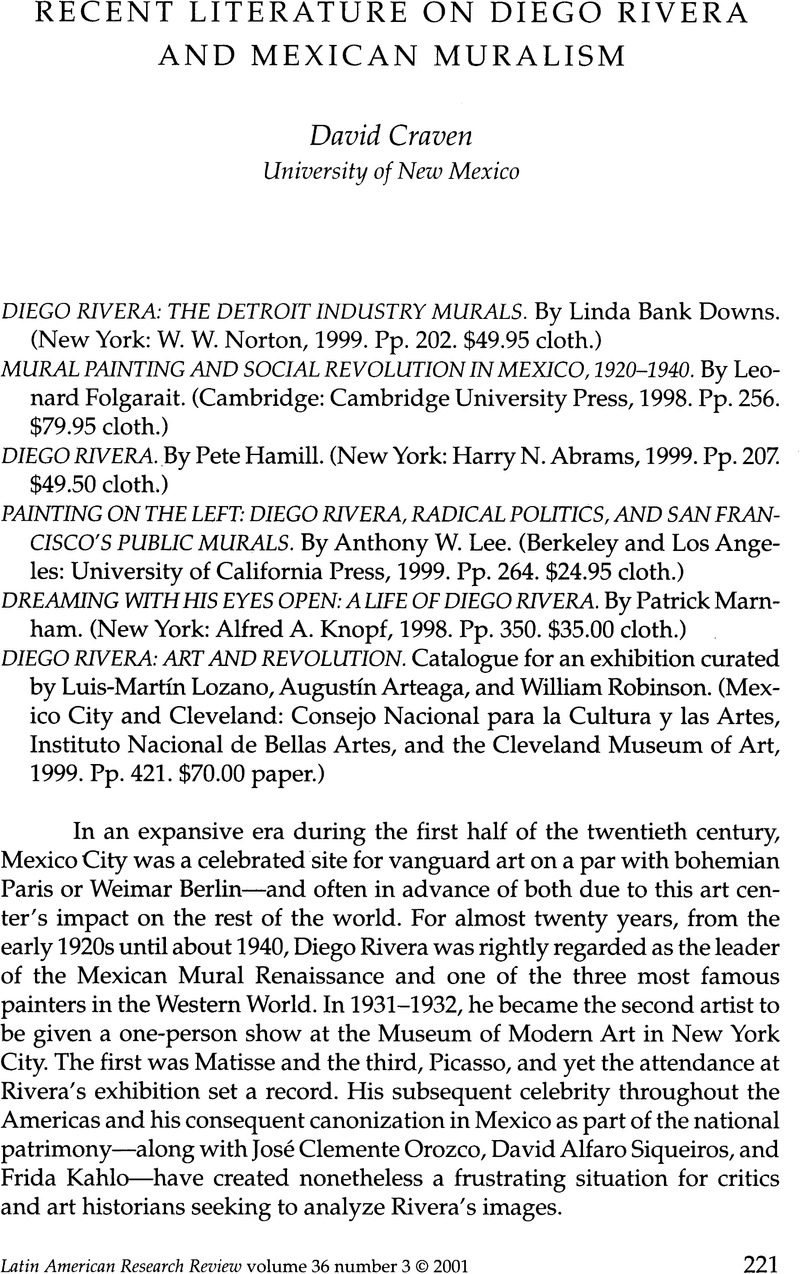Published online by Cambridge University Press: 05 October 2022

1. John Dos Passos, “Paint the Revolution,” New Masses, Mar. 1927, pp. 13–14.
2. Octavio Paz, “Re/Visions: Mural Painting,” in Essays on Mexican Art (1987), translated by Helen Lane (New York: Harcourt Brace, 1993), 132.
3. Edward Sullivan, “From Mexico to Montparnasse—and Back,” Art in America 87, no. 11 (Nov. 1999):102–9, 153, citation on 104.
4. For a more extensive look at the problem of the state, see David Craven, “Marx, Marxism, and Art History,” in Companion to Art Theory, edited by P. Smith (Oxford: Basil Blackwell, forthcoming).
5. Leonard Folgarait, So Far from Heaven: David Alfaro Siqueiros' The March of Humanity and Mexican Revolutionary Politics (Cambridge: Cambridge University Press, 1987).
6. Louis Althusser, “Ideology and Ideological State Apparatuses” (1969), reprinted in Lenin and Philosophy, translated by Ben Brewster (New York: Monthly Review Press, 1978), p. 173. More recently, see Slavoj Žižek, “The Supposed Subjects of Ideology,” Critical Quarterly 39, no. 2 (Summer 1997):39–59.
7. Mary Kay Vaughan, Cultural Politics in Revolution: Teachers, Peasants, and Schools in Mexico, 1930–1940 (Tucson: University of Arizona Press, 1997); and Alan Knight, “The Rise and Fall of Cardenismo, c. 1930–c. 1946,” in Mexico since Independence, edited by Leslie Bethel (Cambridge: Cambridge University Press, 1991), 241–321.
8. The post-revisionist or dialogical concern was central to my book on Rivera, which appeared only a short time before Folgarait's study of muralism in general. See David Craven, Diego Rivera as Epic Modernist (Boston, Mass.: G. K. Hall, 1997).
9. For a well-known look at the political culture passed on by Obregón, see Linda B. Hall, Alvaro Obregón: Power and Revolution in Mexico, 1911–1920 (College Station: Texas A & M University Press, 1981). For an equally enduring examination of the richness of the revolutionary lineage in Mexico long after 1920, see the now classic textbook by Michael C. Meyer and William L. Sherman, with Susan M. Deeds, The Course of Mexican History, 6th ed. (Oxford: Oxford University Press, 1999). The first edition appeared in 1979.
10. Alan Knight, “Rise and Fall of Cardenismo,” 241–42, 245.
11. Mary Kay Vaughan, Cultural Politics in Revolution, 7.
12. Ann Prichard, “Rivera, with a Splash of Red,” USA Today, 21 Oct. 1999, p. 8D.
13. I have analyzed these three frescoes at length elsewhere. See Craven, Diego Rivera as Epic Modernist, 119–29.
14. Hall, Alvaro Obregón.
15. Meyer and Sherman, The Course of Mexican History, 6th ed., 577–78.
16. Marnham's misguided references to art and art history have already been singled out in several other instances by Dawn Ades in her review of Dreaming with His Eyes Open. See “The Many Revolutions of Rivera,” The London Times Literary Supplement, 6 Nov. 1998, p. 17.
17. Diego Rivera: A Retrospective, Detroit Institute of Arts, 10 Feb.–27 Apr. 1986. In addition to Downs's fine introduction and Catlin's invaluable “Mural Census,” the catalogue contains important contributions by Ellen Sharp (co-curator of the show), Laurance P. Hurlburt, Alicia Azuela, Ida Rodríguez-Prampolini, Rita Eder, and several other leading scholars.